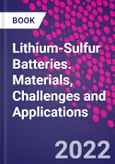Lithium-Sulfur Batteries: Materials, Challenges, and Applications presents the advantages of lithium-sulfur batteries, such as high theoretical capacity, low cost, and stability, while also addressing some of the existing challenges. Some of the challenges are low electrical conductivity, the possible reaction of sulfur with lithium to form a soluble lithium salt, the formation of the dendrimer, large volume variation of cathode materials during the electrochemical reaction, and shuttle behavior of highly soluble intermediate polysulfides in the electrolyte. This book provides some possible solutions to these issues through novel architecture, using composite materials, doping to improve low conductivity, etc., as well as emphasizing novel materials, architectural concepts, and methods to improve the performance of lithium-sulfur batteries.
Please Note: This is an On Demand product, delivery may take up to 11 working days after payment has been received.
Table of Contents
PART 1: BASIC PRINCIPLES�
1. Introduction to electrochemical energy storage technologies
2. A recent development in Li-S batteries
3. Chemistry and operation of Li-S batteries
4. High-performance Lithium-Sulfur batteries: Role of nanotechnology and nanoengineering
5. Mathematical modeling of Li-S batteries
6. Nanomaterials for advanced Li-S batteries: An introduction
7. Nanocomposites for binder-free Li-S electrodes��
8. Separators for Li-S batteries
9. Progress and Perspective of separators towards high-performance lithium sulfur batteries
10. Electrolytes for Li-S batteries
PART 2: NANOMATERIALS AND NANOSTRUCTURES FOR SULFUR CATHODES
11. Porous carbon-sulfur composite cathodes
12. Recent advancement on nanocomposites of carbon / sulfur electrodes for lithium sulfur (Li-S) batteries
13. Advances in nanomaterials for sulfurized carbon cathodes
14. Graphene-sulfur composite cathodes
15. Nanocomposites of graphene-sulfur as cathode materials and separators for Li-S batteries
16. Graphene-sulfur nanohybrids for cathodes in Li-S batteries�
17. Metal-organic framework-based cathode materials in Li-S batteries
18. MXene-based sulfur composite cathodes
19. Polymeric nanocomposites for Li-S batteries�
20. Design of nanostructured sulfur cathodes for high-performance lithium-sulfur battery
21. Nanostructured additives and binders for sulfur cathodes
PART 3: LITHIUM METAL ANODES: MATERIALS AND TECHNOLOGY
22. Metallic Li anode: An introduction
23. Advanced carbon-based nanostructured framework for Li anodes
24. Carbon-based anode materials for lithium-ion batteries
PART 4: APPLICATIONS AND FUTURE PERSPECTIVES
25. Li-S batteries for marine applications
26. Two-dimensional layered materials for flexible electronics and batteries
27. Sustainability in Li-S batteries
28. Recyclability and recycling technologies for lithium-sulfur batteries
29. Recyclability, circular economy, and environmental aspects of Lithium-sulfur batteries








